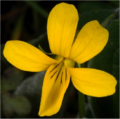Difference between revisions of "Viola nuttallii var. praemorsa"
(Tag: VisualEditor) |
(Tag: VisualEditor) |
||
| Line 1: | Line 1: | ||
| − | Viola | + | Viola ''nuttallii'' (Pursh) var. ''praemosa'' (Douglas ex. Linl.), Family: Violaceae. Canary violet, Upland Yellow Violet, Yellow Montane Violet, formerly V. ''praemorsa'', V, ''praemosa'' vars. ''flavovirens, linguifolia.'' Codon: VIONUT |
==Taxonomy== | ==Taxonomy== | ||
| + | {{Taxobox | ||
| + | | name = Viola nuttallii var. praemorsa| | ||
| + | | regnum = [[Plant]]ae | ||
| + | | subregnum = Tracheobionta | ||
| + | | phylum = Spermatophyta | ||
| + | | classis = Rosids | ||
| + | | ordo = Malgiphiales | ||
| + | | familia = Violaceae | ||
| + | | genus = '''''Viola''''' | ||
| + | | species = '''''V. nuttallii.''''' | ||
| + | | subspecies = '''''var praemorsa.''''' | ||
| + | | binomial = | ||
| + | | binomial_authority = Pursh, Douglas ex. Lindl | ||
| + | | synonyms = | ||
| + | }} | ||
| + | |||
==Description== | ==Description== | ||
General: Perennial from short, erect rhizomes, the stems up to 15 cm. long. | General: Perennial from short, erect rhizomes, the stems up to 15 cm. long. | ||
Revision as of 20:10, 12 April 2020
Viola nuttallii (Pursh) var. praemosa (Douglas ex. Linl.), Family: Violaceae. Canary violet, Upland Yellow Violet, Yellow Montane Violet, formerly V. praemorsa, V, praemosa vars. flavovirens, linguifolia. Codon: VIONUT
Contents
Taxonomy
| Viola nuttallii var. praemorsa | |
|---|---|
| Scientific classification | |
| Kingdom: | Plantae |
| Subkingdom: | Tracheobionta |
| Phylum: | Spermatophyta |
| Class: | Rosids |
| Order: | Malgiphiales |
| Family: | Violaceae |
| Genus: | Viola |
| Species: | V. nuttallii. |
| Subspecies: | var praemorsa. |
Description
General: Perennial from short, erect rhizomes, the stems up to 15 cm. long. Leaves: Leaf blades conspicuously hairy, thick and fleshy, entire, ovate-lanceolate, 5-10 cm. long; petiole 5-15 cm. long; stipules attached to the petiole, the free portion few-toothed.
Flowers: Flowers with peduncles shorter than the leaves; flowers 8-15 mm. long, yellow, the upper petals brownish-backed, the lower 3 penciled with brownish-purple, the lateral pair bearded; style head bearded, rounded.
Fruit: Fruit a hairy, 3-valved capsule, ovary superior, placentation parietal.
Bloom Period
April-July
Distribution
Chiefly west of the Cascades, British Columbia to California.
Habitat
Ecological Setting-Drier areas, valleys and prairies at low elevations. Moisture Regime-Moist Shade Tolerance-Intolerant
Uses
Propagation
Crop Intervals Perennial

